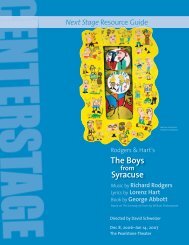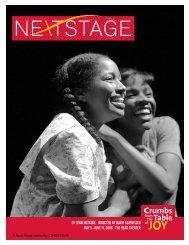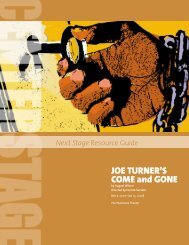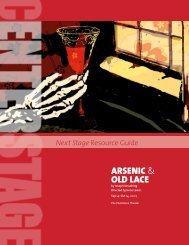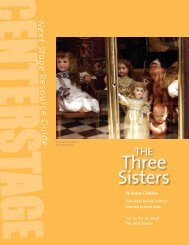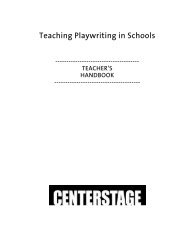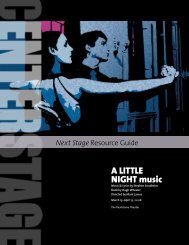The Matchmaker - Center Stage
The Matchmaker - Center Stage
The Matchmaker - Center Stage
You also want an ePaper? Increase the reach of your titles
YUMPU automatically turns print PDFs into web optimized ePapers that Google loves.
BiBlioGr aphy<br />
continued<br />
Penny, Virginia. <strong>The</strong> Employments of Women: A Cyclaopedia of Women’s Work. Boston: Walker, Wise, & Co., 1863.<br />
—Penny, who must have been an extraordinarily dedicated writer, churned out this 500+ page treatise on women in the<br />
workforce (an alternate title was “How Women Can Make Money”) in the first spring of women’s lib. (<strong>The</strong> Seneca Falls<br />
Convention took place in 1848, but Ibsen’s Dollhouse would not be written for almost ten years.) Penny’s book provides a<br />
valuable glimpse at the real lives of many working women in the late 19th century, such as the millineress Irene Molloy and the<br />
matchmaker Dolly Gallagher Levi in <strong>The</strong> <strong>Matchmaker</strong>. (<strong>The</strong> full text of <strong>The</strong> Employments of Women is available for free at www.<br />
books.google.com).<br />
Shorto, Russell. Island at the <strong>Center</strong> of the World. New York: Doubleday, 2004.<br />
—An accessible historical account, told as an adventure narrative, of the early Dutch days in New Amsterdam. Shorto makes<br />
the case that Dutch Enlightenment ideals—mercantilism and absolute faith in the free market, ethnic diversity and tolerance<br />
of other cultures—continue to be felt in New York, specifically on the rambunctious island of Manhattan.<br />
Still, Bayrd. Mirror for Gotham. New York: New York University Press, 1956.<br />
—Still, a distinguished mid-century urban historian and archivist, synthesizes first-person historical accounts from New York<br />
history with precisely written overviews of periods in the city’s history, all presented in short, chapter-size chunks. Ideal to<br />
give actors both a broad sense of their period (in this case, the Gilded Age 1880s and ‘90s in which the modern city began to<br />
emerge) as well as street-level detail.<br />
Van der Donck, Adriaen. A Description of the New Netherlands. Syracuse: Syracuse University Press, 1968.<br />
—One of the founding histocial documents of the colonial period, originally published in the 1660s by Van der Donck, the first<br />
European citizen of Yonkers and the only practicing lawyer in the nascent New Amsterdam. <strong>The</strong> book includes, alongside a<br />
litany of the New World’s alluring landscapes and wealth of raw materials, a brief one-act play titled An Encounter Between a<br />
Patriot and a Netherlander that serves as propaganda for the colonization of the New World.<br />
Criticism & theory<br />
Bentley, Eric. “<strong>The</strong> Psychology of Farce,” Let’s Get a Divorce! And other plays. New York: Hill and Wang, 1958.<br />
—Groundbreaking essay by noted American modernist critic, defending farce in particular and popular entertainments of the<br />
industrial era in a broader sense. Bentley brings such odd couples as Sigmund Freud and Charlie Chaplin, or Adolf Hitler and<br />
Eugene Scribe into his provocative discussion of the form’s purgative potential. Here included as the preface to French farces<br />
by Labiche, Feydeau and other exemplars of the genre.<br />
Bergson, Henri. Laughter: An Essay on the Meaning of the Comic. New York: Macmillan, 1911.<br />
—Bergson’s famous essay on comedy functions as a modern-day Poetics of the form, much in the way that Nietzsche’s Birth<br />
of Tragedy (written in 1872) does so for the tragic drama. To Bergson, comedy hinges on the humanist binaries of empathy and<br />
indifference; his argument is well-wrought, intricate, and one that provides grounding principles when approaching the genre<br />
for practice or pleasure, even if it’s been read once or twice before.<br />
Wilder, Thornton. “Noting the Nature of Farce,” Collected Plays & Writings On the <strong>The</strong>ater. New York: Library of America, 2007.<br />
—In this lucid, brief essay, Wilder demonstrates his impressive erudition and professorial grasp of world-historical dramatic<br />
literature, surveying farcical comedy from its Roman roots to the present day. According to Wilder, farce has an abstract,<br />
logical drive that is corrosive to the interest in character and human emotion that grounds most drama. Similar to Bergson’s<br />
theory of comedy, Wilder notes that successful examples of the form keep the mechanistic and the humanistic in a pleasing<br />
equilibrium, synthesizing the two extremes into an organic whole.<br />
If you have any trouble using this resource guide—<br />
or for more information on CENTERSTAGE’s education<br />
programs—call us at 410.986.4050. Student group rates<br />
start at just $15. Call Group Sales at 410.986.4008 for more<br />
information, or visit centerstage.org.<br />
Material in our Next <strong>Stage</strong> resource guide is made available free of charge for<br />
legitimate educational and research purposes only. Selective use has been made<br />
of previously published information and images whose inclusion here does<br />
not constitute license for any further re-use of any kind. All other material is<br />
the property of CENTERSTAGE, and no copies or reproductions of this material<br />
should be made for further distribution, other than for educational purposes,<br />
without express permission from the authors and CENTERSTAGE.<br />
Next <strong>Stage</strong>: <strong>The</strong> <strong>Matchmaker</strong> |



